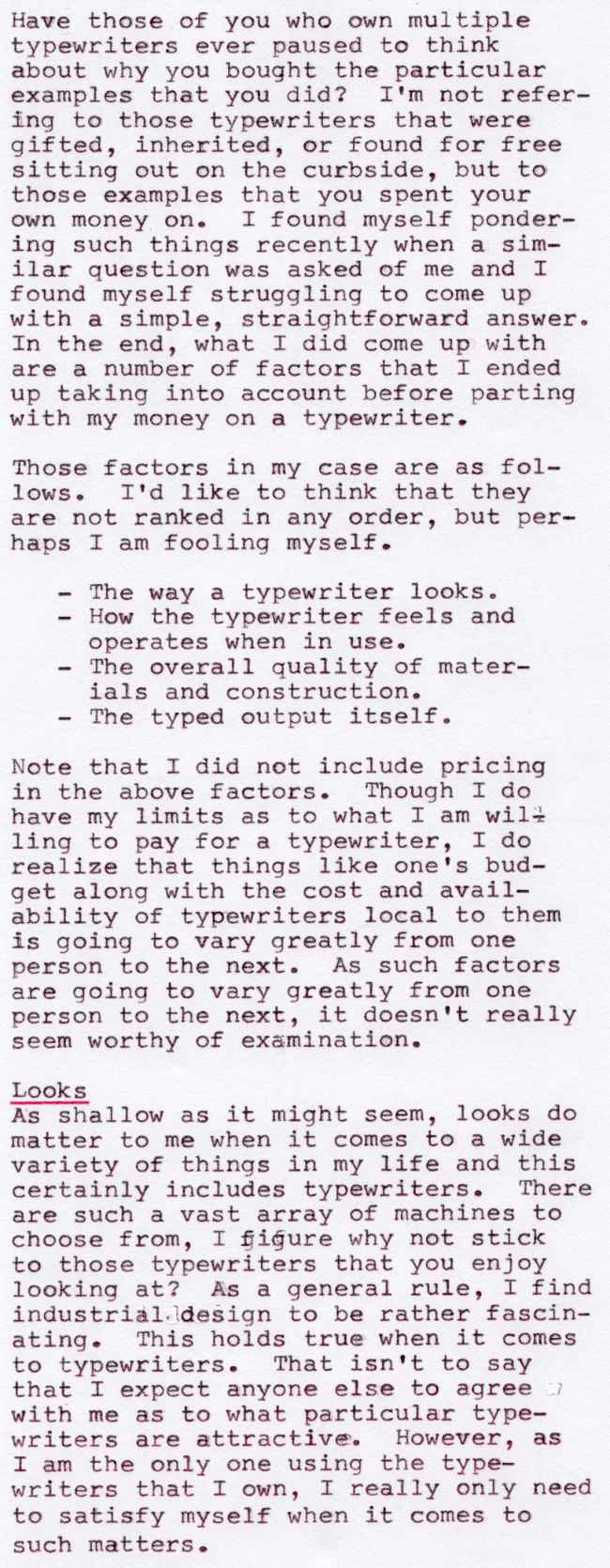
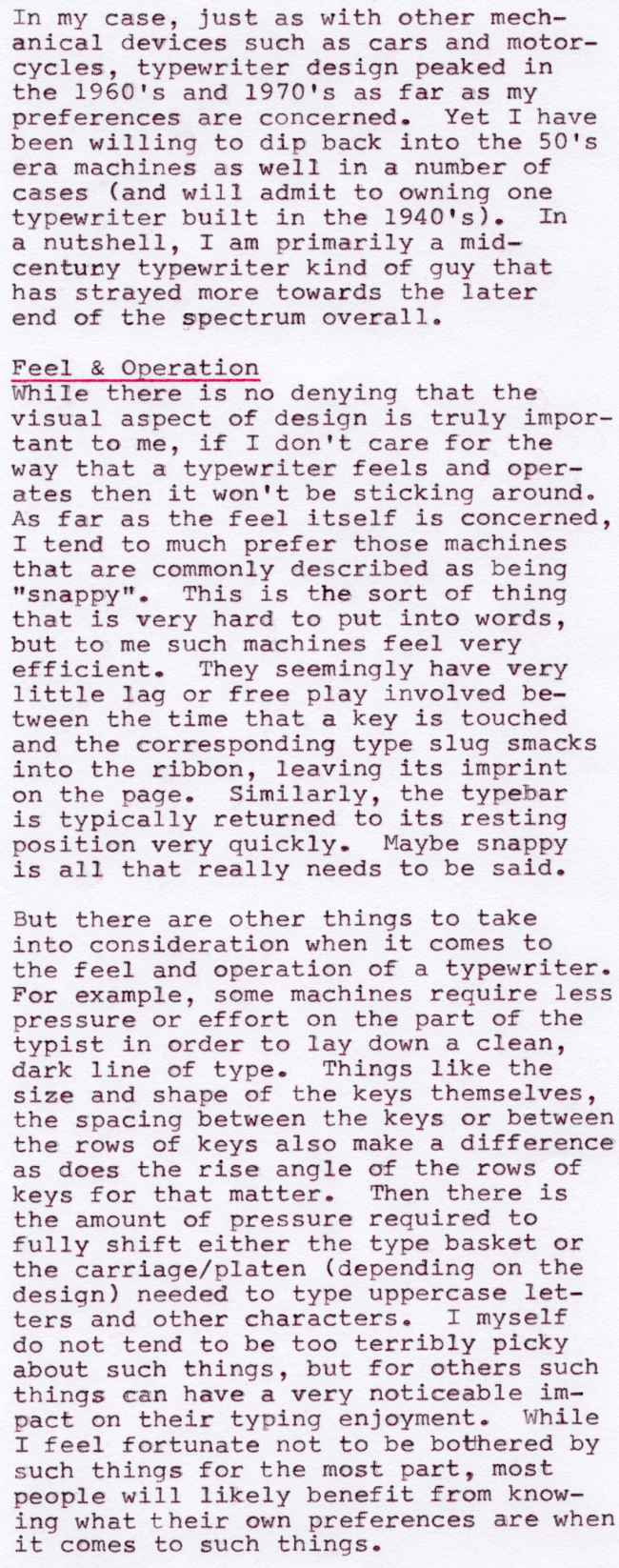
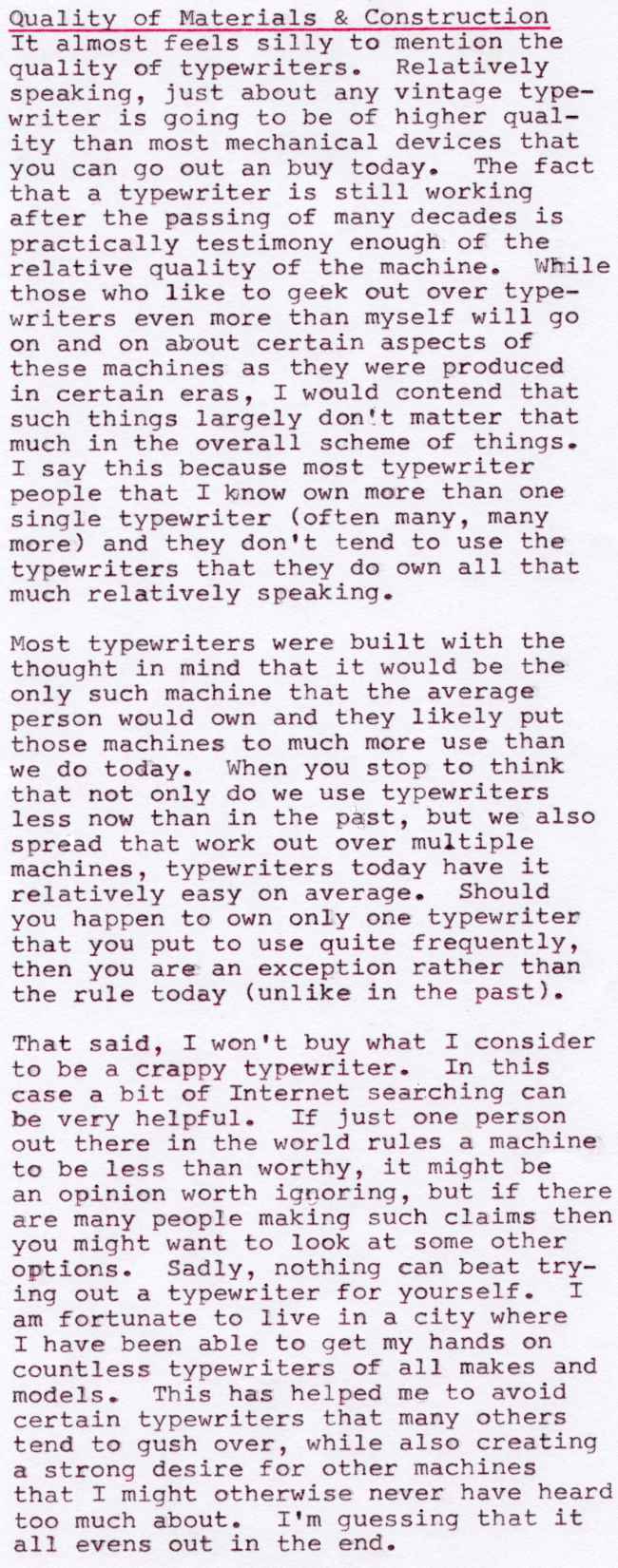
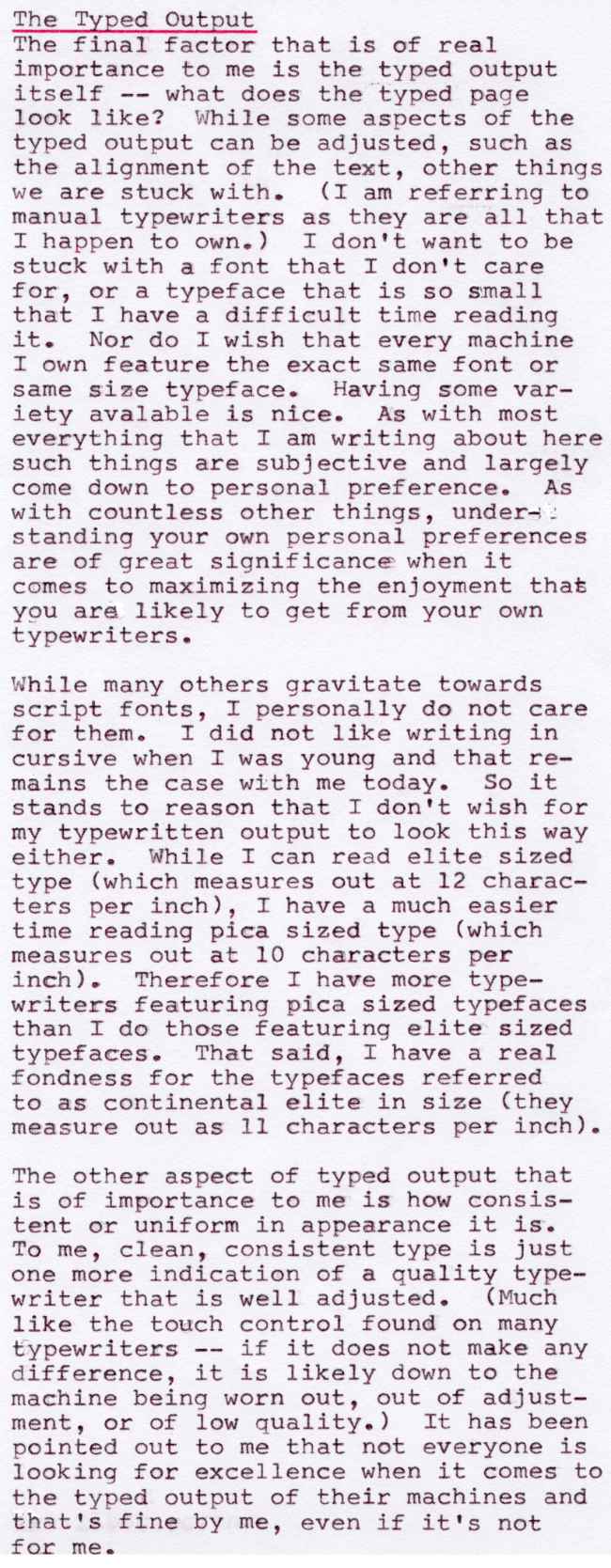
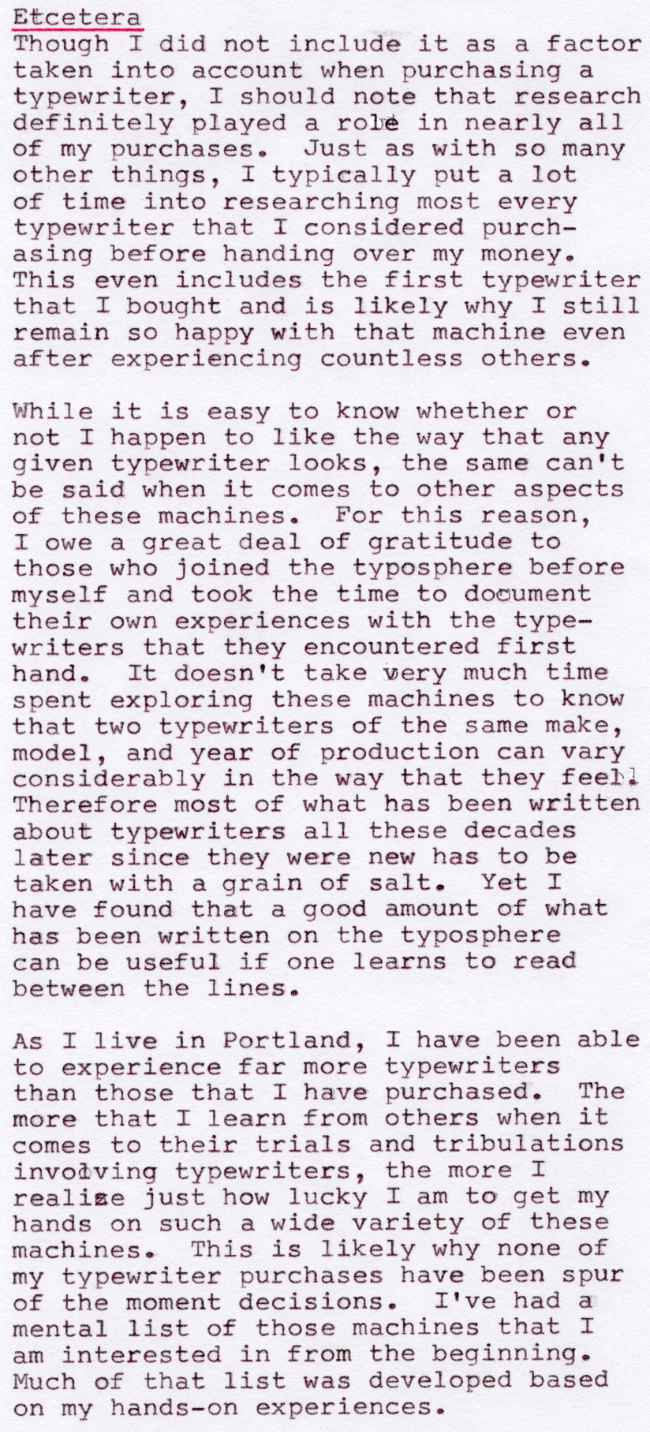
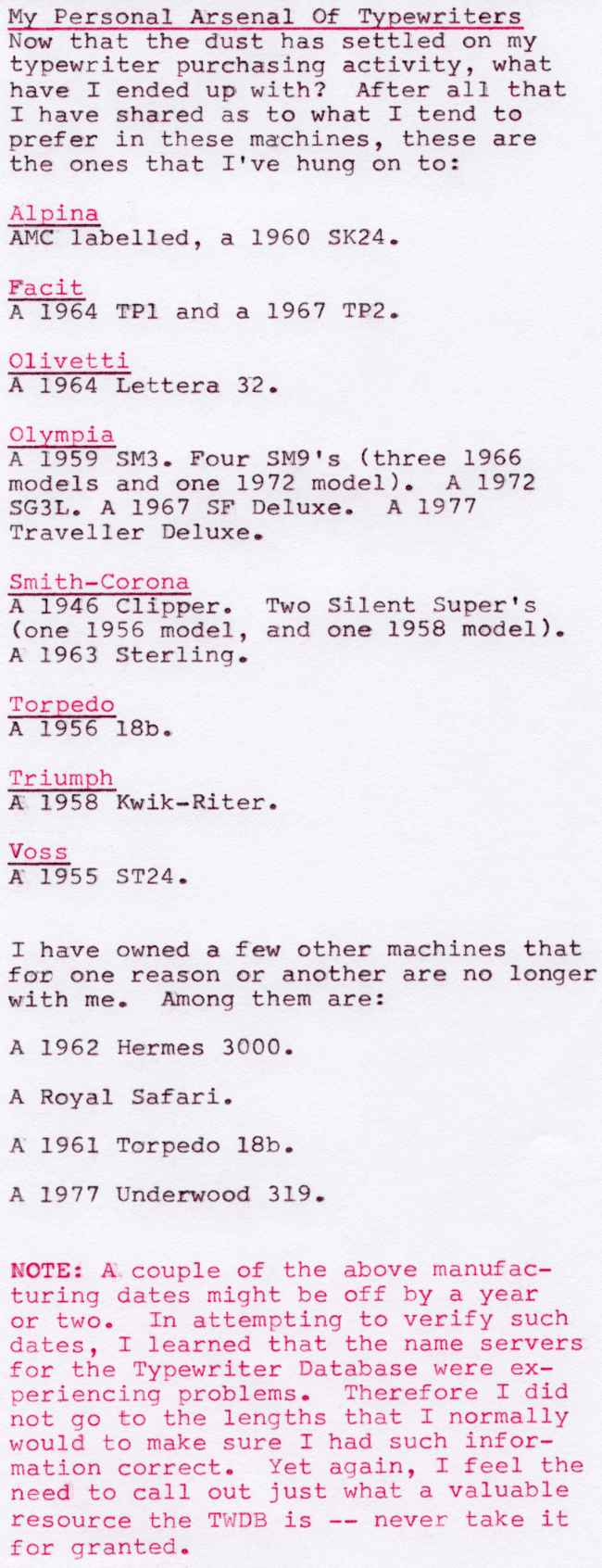
Have those of you who own multiple typewriters ever paused to think about why you bought the particular examples that you did? I’m not refering to those typewriters that were gifted, inherited, or found for free sitting out on the curbside, but to those examples that you spent your own money on. I found myself pondering such things recently when a similar question was asked of me and I found myself struggling to come up with a simple, straightforward answer. In the end, what I did come up with are a number of factors that I ended up taking into account before parting with my money on a typewriter.
Those factors in my case are as follows. I’d like to think that they are not ranked in any order, but perhaps I am fooling myself.
– The way a typewriter looks.
– How the typewriter feels and operates when in use.
– The overall quality of materials and construction.
– The typed output itself.
Note that I did not include pricing in the above factors. Though I do have my limits as to what I am willing to pay for a typewriter, I do realize that things like one’s budget along with the cost and availability of typewriters local to them is going to vary greatly from one person to the next. As such factors are going to vary greatly from one person to the next, it doesn’t really seem worthy of examination.
Looks
As shallow as it might seem, looks do matter to me when it comes to a wide variety of things in my life and this certainly includes typewriters. There are such a vast array of machines to choose from, I figure why not stick to those typewriters that you enjoy looking at? As a general rule, I find industrial design to be rather fascinating. This holds true when it comes to typewriters. That isn’t to say that I expect anyone else to agree with me as to what particular typewriters are attractive; However, as I am the only one using the typewriters that I own, I really only need to satisfy myself when it comes to such matters.
In my case, just as with other mechanical devices such as cars and motorcycles, typewriter design peaked in the l960’s and 1970’5 as far as my preferences are concerned. Yet I have been willing to dip back into the 50’s era machines as well in a number of cases (and will admit to owning one typewriter built in the l940’s). In a nutshell, I am primarily a mid-century typewriter kind of guy that has strayed more towards the later end of the spectrum overall.
Feel & Operation
While there is no denying that the visual aspect of design is truly important to me, if I don’t care for the way that a typewriter feels and operates then it won’t be sticking around. As far as the feel itself is concerned, I tend to much prefer those machines that are commonly described as being “snappy”. This is the sort of thing that is very hard to put into words, but to me such machines feel very efficient. They seemingly have very little lag or free play involved between the time that a key is touched and the corresponding type slug smacks into the ribbon, leaving its imprint on the page. Similarly, the typebar is typically returned to its resting position very quickly. Maybe snappy is all that really needs to be said.
But there are other things to take into consideration when it comes to the feel and operation of a typewriter. For example, some machines require less pressure or effort on the part of the typist in order to lay down a clean, dark line of type. Things like the size and shape of the keys themselves, the spacing between the keys or between the rows of keys also make a difference as does the rise angle of the rows of keys for that matter. Then there is the amount of pressure required to fully shift either the type basket or the carriage/platen (depending on the design) needed to type uppercase letters and other characters. I myself do not tend to be too terribly picky about such things, but for others such things can have a very noticeable impact on their typing enjoyment. While I feel fortunate not to be bothered by such things for the most part, most people will likely benefit from knowing what their own preferences are when it comes to such things.
Quality of Materials & Construction
It almost feels silly to mention the quality of typewriters. Relatively speaking, just about any vintage typewriter is going to be of higher quality than most mechanical devices that you can go out and buy today. The fact that a typewriter is still working after the passing of many decades is practically testimony enough of the relative quality of the machine. While those who like to geek out over typewriters even more than myself will go on and on about certain aspects of these machines as they were produced in certain eras, I would contend that such things largely don’t matter that much in the overall scheme of things. I say this because most typewriter people that I know own more than one single typewriter (often many, many more) and they don’t tend to use the typewriters that they do own all that much relatively speaking.
Most typewriters were built with the thought in mind that it would be the only such machine that the average person would own and they likely put those machines to much more use than we do today. When you stop to think that not only do we use typewriters less now than in the past, but we also spread that work out over multiple machines, typewriters today have it relatively easy on average. Should you happen to own only one typewriter that you put to use quite frequently, then you are an exception rather than the rule today (unlike in the past).
That said, I won’t buy what I consider to be a crappy typewriter. In this case, a bit of Internet searching can be very helpful. If just one person out there in the world rules a machine to be less than worthy, it might be an opinion worth ignoring, but if there are many people making such claims then you might want to look at some other options. Sadly, nothing can beat trying out a typewriter for yourself. I am fortunate to live in a city where I have been able to get my hands on countless typewriters of all makes and models. This has helped me to avoid certain typewriters that many others tend to gush over, while also creating a strong desire for other machines that I might otherwise never have heard too much about. I’m guessing that it all evens out in the end.
The Typed Output
The final factor that is of real importance to me is the typed output itself — what does the typed page look like? While some aspects of the typed output can be adjusted, such as the alignment of the text, other things we are stuck with. (I am referring to manual typewriters as they are all that I happen to own.) I don’t want to be stuck with a font that I don’t care for, or a typeface that is so small that I have a difficult time reading it. Nor do I wish that every machine I own feature the exact same font or same size typeface. Having some variety available is nice. As with most everything that I am writing about here, such things are subjective and largely come down to personal preference. As with countless other things, understanding your own personal preferences are of great significance when it comes to maximizing the enjoyment that you are likely to get from your own typewriters.
While many others gravitate towards script fonts, I personally do not care for them. I did not like writing in cursive when I was young and that remains the case with me today. So it stands to reason that I don’t wish for my typewritten output to look this way either. While I can read elite sized type (which measures out at 12 characters per inch), I have a much easier time reading pica sized type (which measures out at 10 characters per inch) . Therefore I have more typewriters featuring pica sized typefaces than I do those featuring elite sized typefaces. That said, I have a real fondness for the typefaces referred to as continental elite in size (they measure out as II characters per inch).
The other aspect of typed output that is of importance to me is how consistent or uniform in appearance it is. To me, clean, consistent type is just one more indication of a quality typewriter that is well adjusted. (Much like the touch control found on many typewriters — if it does not make any difference, it is likely down to the machine being worn out, out of adjustment, or of low quality.) It has been pointed out to me that not everyone is looking for excellence when it comes to the typed output of their machines and that’s fine by me, even if it’s not for me.
Etcetera
Though I did not include it as a factor taken into account when purchasing a typewriter, I should note that research definitely played a robe in nearly all of my purchases. Just as with so many other things, I typically put a lot of time into researching most every typewriter that I considered purchasing before handing over my money. This even includes the first typewriter that I bought and is likely why I still remain so happy with that machine even after experiencing countless others.
While it is easy to know whether or not I happen to like the way that any given typewriter looks, the same can’t be said when it comes to other aspects of these machines. For this reason, I owe a great deal of gratitude to those who joined the typosphere before myself and took the time to document their own experiences with the typewriters that they encountered firsthand. It doesn’t take very much time spent exploring these machines to know that two typewriters of the same make, model, and year of production can vary considerably in the way that they feel. Therefore most of what has been written about typewriters all these decades later since they were new has to be taken with a grain of salt. Yet I have found that a good amount of what has been written on the troposphere can be useful if one learns to read between the lines.
As I live in Portland, I have been able to experience far more typewriters than those that I have purchased. The more that I learn from others when it comes to their trials and tribulations involving typewriters, the more I realize just how lucky I am to get my hands on such a wide variety of these machines. This is likely why none of my typewriter purchases have been spur of the moment decisions. I’ve had a mental list of those machines that I am interested in from the beginning. Much of that list was developed based on my hands-on experiences.
My Personal Arsenal Of Typewriters
Now that the dust has settled on my typewriter purchasing activity, what have I ended up with? After all that I have shared as to what I tend to prefer in these machines, these are the ones that I’ve hung on to:
Alpina
AMC labelled, a 1960 SK24.
Facit
A 1964 TPI and a 1967 TP2.
Olivetti
A 1964 Letters 32.
Olympia
A 1959 SM3. Four SM9’s (three 1966 models and one 1972 model). A 1972 SG3L. A 1967 SF Deluxe. A 1977 Traveller Deluxe.
Smith-Corona
A 1946 Clipper. Two Silent Super’s (one 1956 model, and one 1958 model). A 1963 Sterling.
Torpedo
A 1956 18b.
Triumph
A 1958 Kwik-Riter.
Voss
A 1955 ST24.
I have owned a few other machines that for one reason or another are no longer with me. Among them are:
A 1962 Hermes 3000.
A Royal Safari.
A 1961 Torpedo l8b.
A 1977 Underwood 319.
NOTE: A couple of the above manufacturing dates might be off by a year or two. In attempting to verify such dates, I learned that the name servers for the Typewriter Database were experiencing problems. Therefore I did not go to the lengths that I normally would to make sure I had such information correct. Yet again, I feel the need to call out just what a valuable resource the TWDB is — never take it for granted.
AFTERTHOUGHTS: I do own one other typewriter that I did not include above, an Imperial Good Companion 5. I was aware that it was not working when I bought it, but won’t likely dig into it for a few more months. As I don’t yet know whether or not I’ll like the way the Imperial types, I might end up hanging on to it or I might not, only time will tell. That said, I have a hard time imagining the Good Companion 5 being a worse performer than the Lettera 32 — a typewriter that I’ve yet to part with simply due to its looks (I find it to be a gorgeous example of design). Not that this should matter as my typewriters all remain in their cases when not in use, with the exception of the Olympia SG3 which sits under a cover.
I could have many more typewriters to show for the money I’ve spent. However, with the exception of the Lettera 32, I’ve tended to prioritize the quality of the typing experiences to be enjoyed over the quantity of typing experiences to choose from. If you have your own set of factors that play into your typewriter purchasing decisions, or any thoughts in general when it comes to buying typewriters please feel free to share.

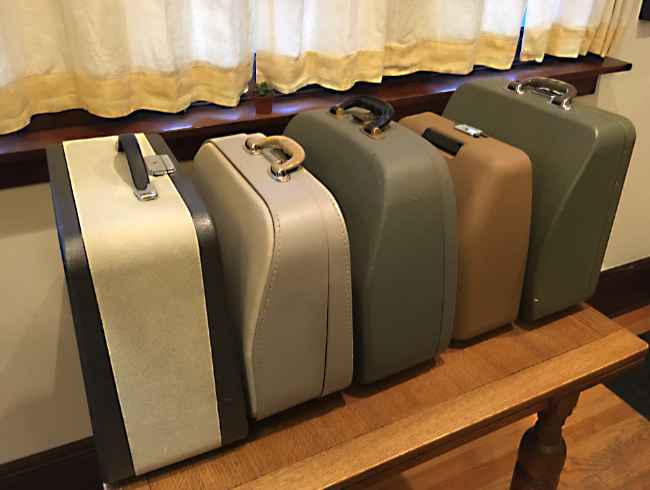
That is an impressive list!, reminds me to do an inventory, i have started that once with labeling etc. but for some reason didn’t finish it.
I hink one of the most import criteria i have is that i don’t like plastic typewriters, still i have a few of those 😉
Greetings,
Indro
Some might find a lot to like among the machines on my list, while others might find that few if any of my typewriters appeal to them. It’s interesting to realize that there were such an incredibly wide array of these machines produced over a very long period of time that we’ve been spoiled with choices. Like yourself, I much prefer the metal-bodied typewriters. Yet I wouldn’t dismiss a machine solely because of a plastic shell.
Beauty, rarity, curiosity, the story behind a particular machine, its reputation in the collectors’ community, mechanical distinctiveness, feel, price … there are so many reasons to splurge!
My view into the world of typewriters is fairly narrow comparatively speaking. Yet I really appreciate that fact that an ever growing number of us can all enjoy these machines even if our reasons for doing so are different. Regardless of the purpose they play for each individual, that typewriters are bringing us enjoyment in this day and age is seemingly one of the things I appreciate the most about them. It’s also comforting knowing that this will likely continue to be the case for well into the future.
It is certainly a journey, which some would say is more important than the destination. (:
The ones I have are the ones I’ve *kept* – which is to say they were mainly not ones I *pursued*, but ones that showed up in the thrifting rounds. Thus, while I’ve had extended testing of at least 150 machines and still have around 50, I find myself rotating the same dozen or so on the desk. I still do have my first (and two others collected in the mid-90’s – one of which got fully restored to factory fresh, and the other retained as a “rat-rod”) and I really don’t feel very much desire to look for any more. Well, I’ll never pass up a $10 SM or JP-1 ever, I imagine.
You got a lot of very nice ones for sure, several great models I’ll prolly never own (Torpedo, Alpina, Facit), but finally I’m at a place where something like that doesn’t cause me ennui. (:
Your words always carry so much wisdom — the Right Reverend Theodore Monk indeed. After watching how things have played out over the past few years with most of my long-term hobbies — things that I’ve been involved with for many decades now such as film photography, listening to and making music (i.e. vinyl records and guitars), vintage motorcycles and cars, I figured that typewriter prices likely had almost nowhere to go but up by the time I discovered their joys. So before prices got to the point I was no longer willing to pay them, I sort of made it a point to get my hands on as many of these machines as possible early on. I’ve been fortunate in that the majority of them I’ve been able to find locally at prices I was willing to pay. My goal has never been to own a large collection of typewriters, but rather to establish a reasonable rotation of those machines that I truly enjoy using.
Essentially, I was attempting to find a shortcut to reach the same point that you find yourself enjoying, while understanding that I was missing out on most of the joy that comes along with the journey just as you’ve described it. I get it. It should come as no surprise to you that have greatly enjoyed my long-term hobbies in large part because of the journey that came along with them.
So while I have managed to put together a nice assembly of typewriters in a relatively short period of time, I doubt that they bring me as much enjoyment as those dozen or so that you currently find yourself rotating between, or those of anyone else who has been involved with these machines for a long time for the very reasons that you’ve mentioned. But I’m turning 60 in a few months and am at the point where I really should start looking into simplifying my life rather than adding to the mess I already have going, lol. Especially as I continue to entertain the thought of moving once again. In my particular case that would mean simplifying — something that I’m NOT good at.
The typewriters themselves are cool. However, it is the people that I’m getting to know because of the typewriters, along with those sentiments that I find myself sharing with many others who have nothing to do with typewriters, that are truly enriching my life at this point.
Simplifying? Do you really want to?
You and I are of similar age and I suspect of similar inclination with regard to mechanical sympathy. There is no doubt my “love language” is closely tied to mechanical objects. Perhaps it’s because of how many wonderful things came during or existed before our formative years. Consider how unusual it is that music from 1960 to 1980 is still widely listened to. That would have been the equivalent of you and me rocking out to Hoagie Carmichael. Some of the most popular cars on the road today are remakes of those from the latter half of the 1960’s. Ford didn’ t resurrect the Model A in 1979 to popular demand. If we haven’t shuffled off this mortal coil we won’t see the current Tesla resurrected in 2059 either.
For whatever reason we find great pleasure in well made devices. I do almost all my calculations on a computer or phone app. On the rare occasion I use a Curta calculator I feel the quality that went into making such an exquisite device and marvel at the intellect behind it. Every time I pick it up it a smile is generated.
What is left behind after I’m gone in terms of material possessions or wealth won’t really make a significant difference either way in anyone’s life. If having those things makes you a happier person while you are here, well, we could do with a few more happy people.
I think that the answer to such a question is going to vary from one person to the next. There are times when I actually do think that I would be happier overall were I to simplify.
Thanks for putting into words what is your own “evaluation grid.”
I had not thought about my own “grid” until now, and seeing yours helped me come to realize what I am now looking for. The thing is, I am not looking for the same things now than I was before.
At first, I only wished to get a typewriter to counter my sentiment of being fed up with how I had to spend so much of my work day on videoconferences after March 2020, because of teleworking. I wanted a different machine for writing, a mechanical device I believed I could clean and repair myself. A sort of return to 1984, a time when I typed my school papers on a typewriter. I therefore got whatever was really affordable from recommended makes by all the people I had started to follow in the typosphere and from Richard Polt’s book.
Now that I have typed on more than one machine, I have a better idea as to what I like and don’t like about the typewriters I bought.
Firstly, I do not like the electronic daisy wheel SCM model I got in a deal with a 1957 Lettera 22, where I had to take both or nothing for $50. Secondly, it needs to type and work well. No heavy touch feeling of the keyboard for me! Typebar electrics seem to do that better for me, but that is evolving as I get better at touch-typing on a manual. Thirdly, I much prefer simple levers, margin stops and controls and a ruled paper bail when I need to write on a variety of paper sizes. Lastly, I prefer portables with a good hard shell case.
All of the above might still be evolving with more use and more purpose…
I can very much appreciate that. There is a lot of value in recognizing if and when our preferences begin to change. I got sort of a crash course when I bought my first typewriter. Even though I walked away with the typewriter that I had originally gone to buy, being able to compare that machine against a good number of others was a real eye opener. That experience more or less provided me with a snapshot of my preferences that are still intact today. All of the machines that I really liked that day felt fairly similar to one another.
Whether I’m conscious of it or not, I tend to pay attention to those things involving touch and feel as those human/mechanical interfaces tend to play a large role in how much satisfaction I get out of using something. This applies not just to typewriters, but also many other things as well such as the feel and responsiveness of gearbox in a car or of the shutter release on a camera, etc., etc.. Upon returning home with my first typewriter, I of course enjoyed typing with it. But I also started doing a lot more research about those other machines with a similar feel that also tempted me and why that might have been. That’s me in a nutshell.
That’s an awesome collection! You’ve inspired me to want to write about my same journey with each typewriter getting a piece of the spotlight. Perhaps that’d be better to write across several blog posts. Hey, that’s another thing to spark our typing – steal topics from other writers! 😀
In short, the reason I began isn’t the same reason I ended up with 50 typewriters. Initially I wanted a typewriter to keep a daily journal, but since I didn’t know much about them, I got a big one and a small one. I could tell right away their typing responses and features were different, and so phase 2 was all about buying for trying as many decent-looking machines for under $50 that I could reasonably fit in my apartment. I enjoy the cleaning and tinkering so much it’s almost like an addiction, always needing another fix, pun intended. I type faster and better on the electric models, so I prefer the 1960s SCMs and my Selectric 2. Whee! The manual ones are great for those slower thoughtful writing sessions or taking machines out and about. As much as I’d love to keep buying more, I’m realizing that 50 typewriters hits the threshold of my living space, so phase 3 will be about curating the collection I have, invest in new platens for my favorites, and WRITE WRITE WRITE!
Or just get a bigger place and be enabled to foster more machines… LOL
More so lately and as my repair skills have grown…
But I find myself more recently acquiring a parts/donor machine to keep another one going or going in the first place after many years of being idle.
There is a bit of a profound sadness when I take apart one machine to transfer those parts to another. In one case…1 parts machine helped bring 2 other, identical machines back to 100%.
There is a joy and satisfaction in doing so, but that haunting sadness is still there when the carcass of the donor machine goes to my local metal recycling place.
Other people’s opinions usually cause me to pause and then kick the tires. Comfort rates high. But once I settle n one I’m like a one-woman-man. I don’t stray. But I only own two manuals and a Brother.
In my case, the Smith Premier typewriters were so different than anything I had seen, with their double keyboards and in some cases strange symbols (who puts directional keys on their typewriters and what were they used for?), that it was the “How cool is that!” factor with them. But, I am also a user of typewriters. Believe it or not, the Smith Premier typewriters (once they are cleaned and serviced) can once again be used to type. Isn’t that what most typewriters want, to be used? Note I said most. There are some that cannot be used for one reason or other. With my ‘modern’ typewriters (1920-and later), I like them to work, and then look somewhat decent. However, some of my favorites don’t look that great, but work fairly well.
Aloha Bill,
Great to see that your website is up and running for the New Year.
“Why I bought or own the typewriters I have?”
Looks, feel, collectability (cool factor), quality/workmanship. Above all, ease of use and overall functionality that invite me to use the typewriter as intended, and is rewarding to do so. I have to be able to type well on them to keep them.
Fully restored, mint condition:
1970 Hermes 3000 (Swiss workmanship is outstanding)
1956 Royal Quiet Deluxe
Olympia (love the craftsmanship): ST, SM4, SM9 (pica and elite)
1929 Smith Corona Portable (beautiful and very functional)
1950 Smith Corona Sterling
1948 Hermes Baby (one of my first vintage typewriters, 40 years ago)
*(SCM mostly Series 6 based. Most in excellent refurbished condition…they are very reliable and perform and are relatively simple to service and find parts for).
1960/70’s: Galaxie’s, Classic’s, Electra’s 120/220/250 Secretarial, Coronamatic Super 12.